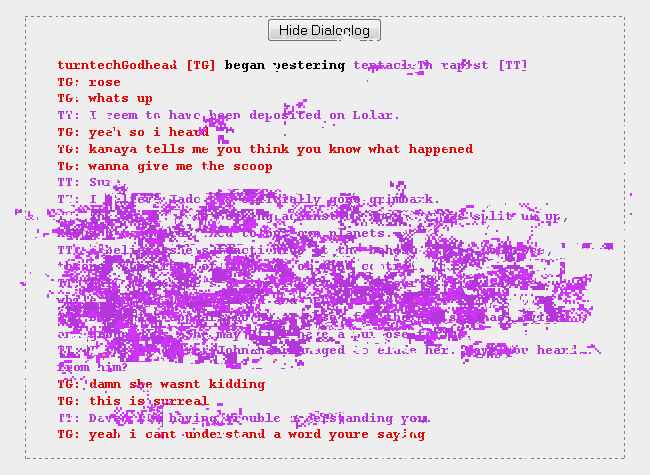Let Me Tell You About Webcomics: A New Postmodern Genre
by Paige Gelsimino
In Homestuck, some of the print is set up as chatlogs between certain characters. It’s displayed just as if the reader was looking at someone typing back and forth between each other. Below is page 006057 where Jane (gutsyGumshoe) is contacting Roxy (tipsyGnostalgic) about getting mail.


The reader clicks on the pesterlog button to begin reading the chat. There are even some points in the chatlogs where the characters send links to one another, like when Dave and Terezi are chatting and they send pictures they draw to each other. The reader can then click on the link and it’ll take the reader to the picture Dave or Terezi sent. This is something that a normal print comic wouldn’t be able to do. A print comic may be able to imitate this sequence, showing images of clicking on a link and looking at it, but in a webcomic the reader can actually do these things. The reader is clicking on an actual link that opens up another tab on their web browser for them to view, helping create a new reality for the reader.
There’s also another point in the webcomic where the “Homestuck game cartridge” is damaged, causing some of the text to be unreadable, not just to the reader, but to the characters attempting to talk to each other. When Dave (turntechGodhead) wakes up on LOHAC with no memory of how he got there, he attempts to contact Rose (tentacleTherapist).

A few of their sentences are readable but then a glitchy glittery substances blocks out the words for the reader and Dave. These special effects tend to effect the whole website the webcomic is hosted on, also making it seem more realistic and playing into Homestuck’s reality.
Also to discuss certain important points in Homestuck it has one of the characters, Rose, write out a Game FAQ that the reader can view, which gives helpful plot points that the reader may be confused on, as well as still being in the Homestuck reality. It isn’t just some Game FAQ written by the author, it’s written by Rose, a character within the webcomic. Sometimes even Andrew Hussie, the author of Homestuck, will insert himself, as a character, into the narrative to tell readers what has happened so far. These are all different ways Homestuck transcends boundaries in order to communicate the narrative.

Homestuck also utilizes flash animations, which are usually accompanied by music. In Homestuck there is a flash animation of Terezi confronting Vriska on deciding to fight Jack by herself. Before this, the second disc for Homestuck, which was damaged, got inserted anyway. So the next few panels and this flash animation imitate being glitchy. In the flash animation, [S] Flip, it glitches and skips along with the music until the end of the flash, where it gets stuck, playing the same image and music over and over again. Watch the video below to see it for yourself!
The reader can really experience how the disc is damaged because of the scratch. It’s just as if a real disc had been inserted and was trying to play while being scratched up.
In Homestuck the reader can also play interactive games, such as when the reader is playing as Jane and has to find bones, move lanterns, unlock rooms and talk to characters. There are several puzzles the reader needs to figure out, but unlike a video game, the reader does not have to complete the game to go on to the next stage.

The reader might miss something important to the story, but they are not forced to play until they win. This is another way webcomics leave behind the boundaries set up by print comics. An interactive game would be impossible for a print comic, but in a webcomic the reader can explore the world and reality of Homestuck even better.
There's also times Homestuck works to move outside of the page and explore the “infinite canvas” that Shedd describes. Even though the monitor is a fixed space, the space it shows doesn’t have to be. Instead of thinking of “the monitor as a page, treat it as a window through which one can observe a larger space. Instead of being stuck in a small rectangle, a web comic may trail off the side of the bottom of the screen, inviting the viewer to scroll over and view more content which isn’t visible in the current 'window’” (Shedd). One instance of this is when one of the characters, Caliborn, takes a crowbar and begins “breaking” the site that the reader can read Homestuck on. Caliborn makes the internet page seem exactly what it is, a window into an infinite space. He hits the computer screen with his crowbar and links fall down and bits of the webpage bounces up and down with each hit, giving the reader a reality that the print comic cannot. Click the image below to see this in action!
Homestuck also explores the dimensions of the webpage with its flash animations. Instead of staying on the set place where the video player is, it can expand and contract as Hussie wishes it. Sometimes the reader will have to scroll to see all that is going on as the flash extends beyond the webpage. One of these flashes is [S] Act 6 Act 6 Intermission 1. During several scenes the screen the flash animation is playing on will grow bigger, covering up the rest of the website, and then shrinking back down for another scene. Click on the image below to view [S] Act 6 Act 6 Intermission 1, as the best way to see it in action is by watching it on Homestuck.
This is a great example of how the webcomic doesn’t need to fit into a frame and constantly breaks out of it.



